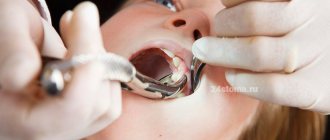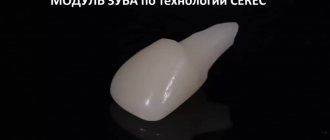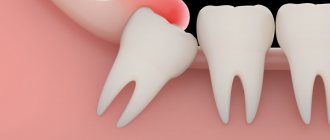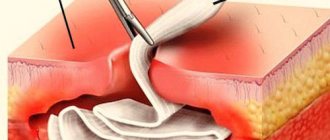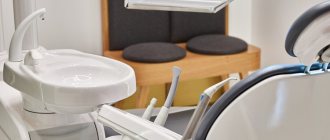If the child’s jaw develops correctly, then the replacement of teeth occurs as follows: first, the roots of the baby teeth dissolve, then the teeth fall out of the gum tissue, after which new, already permanent ones grow in their place. This is a natural process that does not require intervention.
If everything goes well, then by a certain age all baby teeth will be removed from the mouth, and straight and healthy permanent teeth will grow in their place. However, the picture does not always look like this. Sometimes parents notice that their child’s second row of permanent teeth grows even before the baby tooth falls out.
You need to pay attention to this, since new teeth can be impacted, that is, partially remain in the gums. And retention, in turn, can lead to inflammation, fever and sometimes even suppuration. Therefore, at the first signs that the child’s second row of teeth is growing, you should immediately contact a pediatric dentist.
Content:
- Causes of the anomaly
- What does a “shark” smile lead to?
- When to see a doctor
- When to hesitate to see a doctor
- How is the treatment carried out?
The situation when a molar has erupted, but the milk tooth is in no hurry to leave its place, dentists call a “shark” bite. This is due to the fact that sharks also have units arranged in two rows. In humans, such an anomaly does not look aesthetically pleasing at all. Parents usually get very scared when they see a “double” smile on their child. Should I be concerned if a tooth comes out but the baby tooth does not fall out, and what could this lead to? Let's figure it out together.
Reasons why teeth grow second row
Teething pathology can be caused by the following factors:
- chronic diseases, various infections;
- problems arising during the development of milk units, which subsequently has a negative impact on the formation of root incisors or molars;
- genetic predisposition;
- unbalanced diet;
- deficiency in the body of vitamins and minerals necessary for the proper formation of teeth;
- incorrect location of the primordia.
Causes of the anomaly
If the permanent tooth is erupting but the baby tooth has not fallen out, it can be assumed that the child is not eating enough solid food. With a deficiency of chewing load, the roots of temporary units are in no hurry to dissolve.
The diet of modern children is indeed too “gentle”, one might even say refined. It consists of products that have undergone step-by-step heat treatment. Chewing them requires almost no effort.
If parents think that children need to be given soft and thoroughly steamed food, then they are mistaken. To change teeth in a timely manner and form a correct bite, you need to eat a lot of fresh vegetables and fruits, and other foods that require careful chewing. Then the problem of preserving primary canines, incisors and molars for too long will not arise.
Another possible cause of the problem described is the presence of scars on the gums. If in the first years of life the baby has undergone dental surgery or received a serious injury, a burn to the oral cavity, scars may form on his gums. They consist of very dense connective tissue that prevents teeth from erupting.
Echo of childhood
Milk teeth are something from the realm of a carefree and touching childhood, most of us are sure. It is not for nothing that the Scottish writer James Barrie, in the fairy tale about Peter Pan - a boy who did not want to grow up and remained forever young - specifically mentions that “his mouth was full of pearly milk teeth. None have fallen out yet.” Replacing baby teeth with permanent ones is the same step into adulthood as first grade and first grade.
The change of teeth begins at the age of 5–6 and usually ends by the age of 14–16. Moreover, according to the observations of doctors, children are currently replacing their baby teeth with permanent ones at a younger age than several decades ago. But sometimes baby teeth persist into adulthood. People encounter similar cases at 20, 30, and even 50 years old! Why does this happen and what should be done in this case?
What does a “shark” smile lead to?
Should you be scared if a new unit comes out, but the milk unit does not fall out? This situation should alert parents. Double dentition can lead to problems with articulation and diction. Then the child will have difficulties with the correct pronunciation of sounds and words.
Also, many patients with the described anomaly have difficulty eating food - they feel uncomfortable biting off hard foods, and when chewing them, small particles often get lodged under the gum. This means that the child will get used to swallowing poorly chewed food. This leads to disturbances in the functioning of the gastrointestinal tract, including flatulence and abdominal pain.
It happens that children who have double units in several places at once begin to lose weight. This is again due to improper chewing of food. During a meal, they swallow large pieces and because of this they swallow a lot of air. Therefore, they often have the illusion of satiety - a feeling of fullness when very little has been eaten.
Among the dental complications caused by untimely change of units:
- caries;
- inflammation of the gums;
- deposition of a large amount of soft plaque.
Therefore, you should not put off visiting the dentist. The doctor will conduct an examination and decide whether to remove the extra unit.
Causes and consequences of dental pathology
Abnormal two-row growth is possible for many reasons:
- heredity;
- chronic colds and decreased immunity;
- unhealthy diet with a predominance of soft foods and purees;
- lack of vitamins and useful elements;
- premature removal of milk units;
- disturbance in the location of tooth germs.
With timely treatment, the orthodontist will easily straighten the bite and place each tooth in its proper place. If you delay visiting a doctor, the consequences can be serious:
- malocclusion;
- problems with hygiene and the development of caries;
- facial deformation due to jaw imbalances;
- ugly smile.
A sign of a potential shark jaw is the absence of gaps between the teeth in a 4-6 year old child. Insufficient space is the first prerequisite for the appearance of a second row of teeth in children and a signal for an attentive parent.
It is easy to see an incorrectly growing tooth, especially in the lower jaw. During the period of change in bite, dentists recommend monitoring the process - periodically conducting home or professional examinations and listening carefully to the baby. Complaints of discomfort in the mouth, inconvenience of chewing and pain indicate the need to visit a dentist to assess the condition of the oral cavity.
When to see a doctor
Doctors believe that a “shark” smile can last up to two to three months, then it is necessary to take action. If the baby tooth does not fall out within the specified period, it needs to be removed. If you do not do this, the complications described above may occur.
But what’s even worse is that the child’s bite may be disrupted. The permanent unit will take the wrong position or be at the wrong angle. Then you will have to correct its position using plates or braces, and this is always difficult and time-consuming.
It is important to know! If a permanent tooth has come out, but the baby tooth has not yet fallen out, you can monitor the situation for several weeks. It is important to ensure that the child carefully maintains oral hygiene. If after two or three months nothing has changed, you need to make an appointment for your baby to see a dentist. But this recommendation is relevant only if the little patient is not bothered by anything and does not complain of toothache.
What to do if a tooth protrudes? About orthodontic movement of individual teeth...
Very often, when we lose our back teeth, we do not immediately run to the dentist to somehow fill the gaps in the dentition. The loss is not noticeable to those around you, you can still chew... well, God bless him! Many people decide this for themselves. What problems this leads to in the future, and how to deal with these problems later, you can see in today’s post.
What happens to your teeth if you have not restored extracted teeth for a long time? They are moving. Moreover, both teeth adjacent to the lost one and those located on the opposite jaw can shift.
This process occurs at different speeds for different people, but the result is always the same - the inability to properly restore a missing tooth, because there is simply no room left for him.
The more time passes after the removal of a tooth and the refusal of its prosthetics, the more the teeth shift. Unfortunately, the resulting dental deformations can lead to new problems. From difficulties with prosthetics to diseases of the temporomandibular joint due to significant malocclusion.
Here, for example, is one of the deformation options.
Due to the long absence of lower teeth, the upper molars have moved downwards. Yes, and so much so that the upper 7 has already rested against the gum of the lower jaw. Now, no matter how much we want, we won’t be able to put a crown on the bottom. There's simply no room for it. What to do in such a situation when the teeth have moved out and do not allow restoration to be made on the opposite jaw?
There are 3 main options:
1. Orthodontic movement of protruded teeth into their place.
2. Filing of protruding teeth.
3. Removal of protruding teeth.
I'll start from the end. Extraction is the last resort when teeth are strongly protruded (approximately as in the photo above) and the patient has no desire to engage in orthodontic movement. Although, if the “gone” tooth is on its way out, then its removal may be the most rational way out of the situation.
Filing teeth is not a very desirable measure. If the protruding tooth is alive, then grinding down the hard tissues can lead to increased sensitivity. If significant grinding is necessary (and this happens quite often), it will be necessary, among other things, to depulp the tooth (remove the nerve from it) and cover it with a crown. Until recently, this was what was done most often. True, in such a situation it will be necessary to file 2 teeth “just” by more than half the length...
Of course, the stumps remaining after such filing will no longer resemble teeth. What to do? Today there is a much more humane way to deal with a tooth that has escaped from its place. Orthodontists help us with this (not to be confused with orthopedists), who professionally know how to move teeth back and forth along the jaw.
How do they do this in cases like the one I presented at the beginning of the article? There can be many ways, depending on the general situation with the bite. But for the sake of simplicity, I will show only one example, which my colleagues, surgeon-implantologist Oleg Yuryevich Ponomarev and orthodontist Daria Sergeevna Kostina, kindly shared with me.
A very common situation was chosen as an example. The patient lost her lower sixth tooth a long time ago. Finally, I decided to restore it a few years later with an implant. It was placed in one of the clinics in our city, but there was not enough space to put a crown on it. This happened due to the upper “six” “sinking” into the empty space. And this is clearly visible in the photo.
The patient refused the attending physician’s offer to file the tooth and went to see my colleagues. As a result, it was jointly decided that this tooth could be reintroduced using mini-implants . How was this done?
First, Dr. Ponomarev installed 2 mini-implants - one on the cheek side, the other on the palate side.
This operation is outrageously simple and not scary. No cuts, no seams. Mini implants have nothing in common with “adult” implants Anesthesia, try it on, whack... whack... and everything is ready. Of course, in skillful hands everything looks simple. There are times when, without really calculating the position of the roots of the tooth, the incompetent doctor screws this very mini-implant straight into the tooth. Such inattention can lead to the removal of an injured tooth. So, as with everything, you need to apply knowledge and skills to make this manipulation truly invisible to the patient.
Well, then the orthodontist comes into play. Dr. Kostina glued special hook buttons to the tooth and tied these hooks to the heads of the mini-implants with rubber bands. This is what it looked like from the cheek side...
and here it is from the sky:
The arrow shows the direction of the force vector that is applied to the tooth by an elastic band. In this case, mini implants act as a support. Now all that remains is to periodically change the weakening rubber bands from the doctor and monitor the movement of the tooth. Depending on the degree of tooth displacement, such treatment can take from 2-3 to 7-8 months.
Some orthodontists do not glue hook buttons to the tooth, but simply throw an elastic band from one miniscrew to another through the tooth. But in this case, the elastic often breaks and can jump off the tooth, cutting into the gum, forcing the patient to re-stretch it, take it off and put it on, etc. Doing this on your own is certainly not very convenient.
So, when the space for the crown of the opposite tooth is cleared, you can begin prosthetics. And my tooth remained intact and unharmed! And this fully confirms the desire of modern dentistry to be minimally invasive (i.e., without the need to interfere with what nature has done).
So there are two main points you should take away from this article:
1. If you have lost a tooth, you should not delay with its prosthetics. In the future, if the teeth are displaced, it will be extremely difficult and sometimes impossible to make adequate prosthetics without additional interventions, including the removal of healthy teeth that have crawled out of place too much.
2. If for some reason you did not have time to close the defect in the dentition in time, and the teeth have shifted, it is best not to saw them, but to put them in their rightful place.
Illustrations for the article were provided by my colleagues:
Ponomarev Oleg Yurievich (implant surgeon)
Kostina Daria Sergeevna (orthodontist)
When to hesitate to see a doctor
If a “shark” problem appears and the child complains of pain, the gums are inflamed, swollen, you need to immediately get dental care. Also warning symptoms are:
- bad breath;
- bleeding of the affected gums;
- separation of pus in the area of inflammation;
- severe discomfort while chewing food.
You should not wait a day if the child has a predisposition to malocclusion, for example, if he has previously undergone treatment for malocclusion or one of the parents wore braces. In all these situations, removal should be carried out as soon as possible. This measure will be a good prevention of possible complications.
Growth of baby teeth in the second row
Hyperdontia (supernumerary tooth) in the picture
The rudiments of baby teeth are formed in the womb, so their pathologies are associated with a lack of space in the jaw for all the incisors. Among the most common reasons that provoke improper growth of baby teeth:
- unbalanced diet of a woman during pregnancy;
- deficiency of calcium, fluorine (essential microelements necessary for the formation of bone tissue);
- lack of solid food;
- uncontrolled use of a pacifier;
- heredity.
It also happens that molars and molars come in second row. This phenomenon is explained by the following factors:
- underdevelopment of the jaw, due to which there is not enough space to accommodate a full set of teeth;
- hyperdontia (superset of teeth).
How is the treatment carried out?
When choosing treatment tactics, the dentist takes into account:
- how old is the patient;
- how long ago the permanent unit emerged;
- how much the molar crown appeared;
- what condition is the milk unit in;
- does the child have any complaints;
- general condition of the dentition;
- the patient has a predisposition to dental anomalies.
After conducting an in-person examination, the dentist decides whether to pull out the interfering tooth or leave it and wait until its roots resolve on their own. In the first case, local anesthesia is administered and removal is carried out; in the second, the doctor tells you when the baby needs to come for a second examination. Thus, if you deal with the problem of a “shark” smile in a timely manner, it will not cause negative consequences.
The result of implanting a wisdom tooth in place of a six
The chance of such a tooth to take root with autotransplantation is almost 100 percent
. Why? Because the transplanted tooth has a large number of its own living tissues, which fully correspond to the tissues of the patient’s body. This is not a foreign body like, for example, a titanium implant. And it is absolutely its own piece of the body, which, subject to the transplantation technology, will not be rejected in the future.
The results of computed tomography show excellent survival of the transplanted tooth.
All 4 canals in the transplanted wisdom tooth are treated and hermetically sealed.
Based on the results of observation after 6 months, it is clear that the bone tissue is fully formed
, there are no empty spaces in it.
The bone around a tooth is identical to the bone around adjacent teeth. The patient was very happy about this possibility of implantation, which was successful and will delight him for many years. The patient learned about the benefits of wisdom teeth. According to the patient, the wisdom tooth transplant was initially unexpected for him, and he was very surprised by its prospects and opportunities provided by the doctors of the German Implantology Center.

